Affiliate disclosure: This post may contain affiliate links. Please see our Privacy Policy.
Witch Hazel Extract is known for its antimicrobial and astringent properties, and it’s been used for centuries as a natural disinfectant and wound cleanser. Learn how to make your own witch hazel extract in a few easy steps.
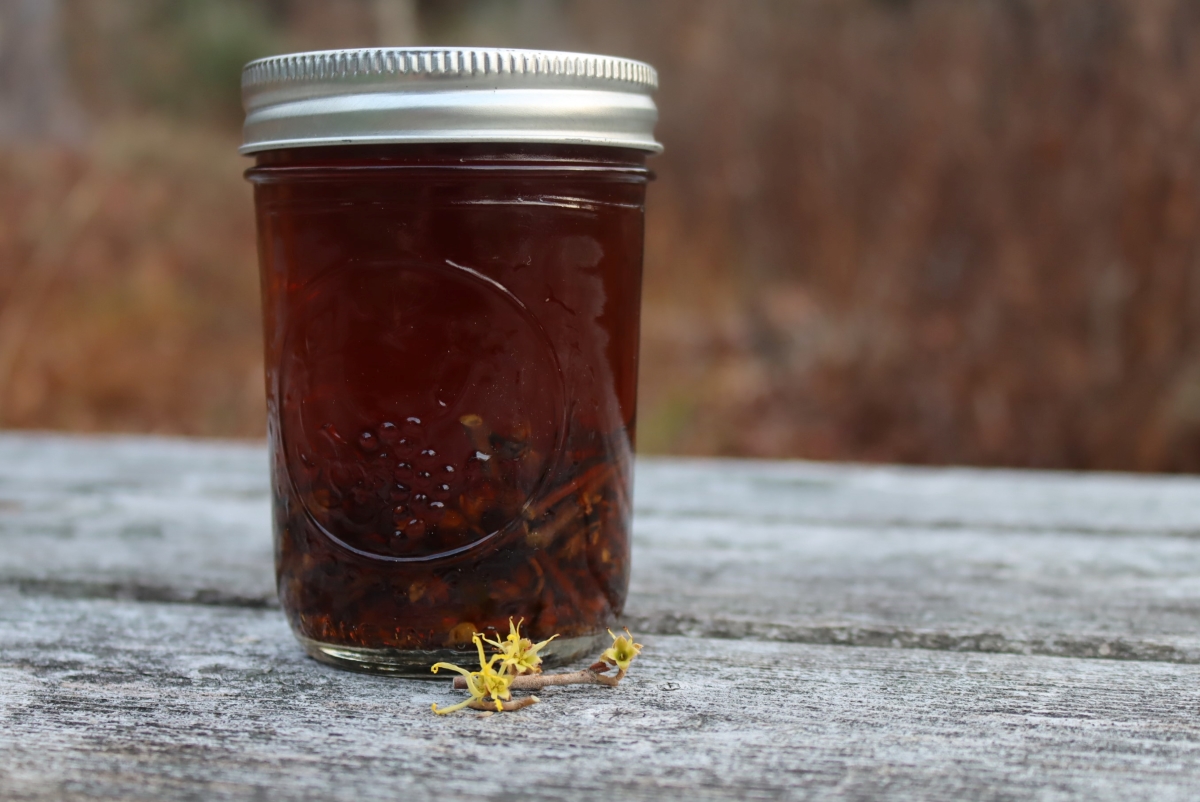
Witch hazel extract can be found at just about any health food store or natural foods coop, and it’s pretty common in everyday grocery stores and drug stores too.
The problem is that the pre-packaged witch hazel extract available in stores has very little actual witch hazel inside. It’s almost all alcohol, which is also a disinfectant, but if you wanted a bottle of isopropyl alcohol, you could easily buy it for 1/10th the price.
High-quality witch hazel extract is usually advertised as “low alcohol witch hazel,” which is much more expensive but only has around 12-16% alcohol to preserve the fresh plant extract. (It’s also much more expensive.)
Why buy it, when you can just make it?
Learning to make witch hazel extract means you always have the knowledge to craft your own natural herbal anti-microbial cleanser, whether you’re deep in the backwoods or simply crafting in your kitchen.
What is Witch Hazel?
American witch hazel (Hamamelis virginiana) is a really unique shrub native that can be found all across the eastern half of North America (range map). It’s a perennial bush that grows no more than a few meters tall, and has many stems originating from the roots.
Wild witch hazel can be found near streams, ditches, and wet lowlands, but it’s also commonly cultivated as an ornamental. The unique blooms look like streamers bursting out of the central blossom, and showy varieties have been bred to almost look like pompoms.
My native witch hazel is much more subdued, but the blossoms are still unique and beautiful.
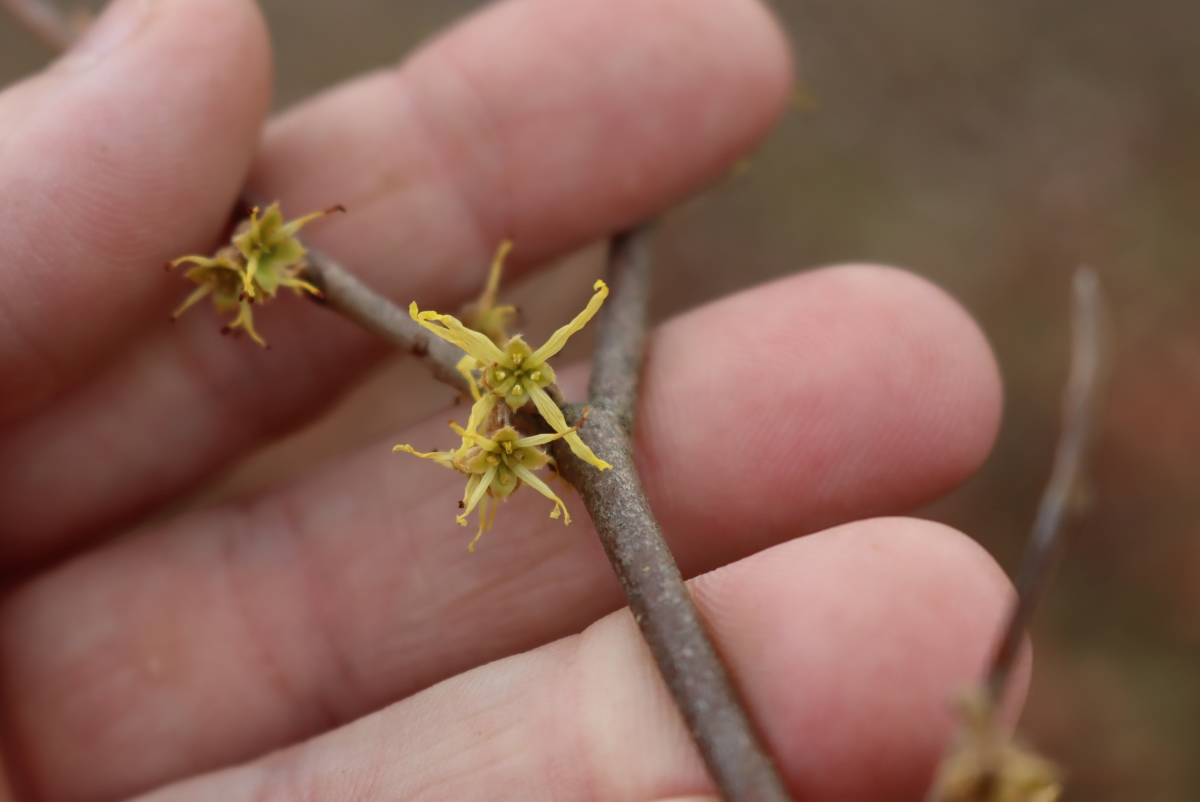
Witch hazel blooms in the late fall, long after everything else has gone dormant. Here in Vermont, blossoms appear around Thanksgiving and persist until mid-December. Our first frost is usually sometime in September, and we often have snow on the ground by October, so that’s rather late.
A related species, Ozark Witch Hazel (Hamamelis vernalis) grows further south and actually blooms mid-winter.
If you can positively identify witch hazel in the wild, the best time to harvest is actually during bloom or right after, as that’s when the medicinal constituents are the most concentrated in the plant tissues.
(I’ve also read other sources that say it’s best to harvest during spring when it’s just breaking bud and sap is running, so clearly, there’s some disagreement on this based on the source you check. Regardless of the “best” time, it can be harvested year-round.)
All the aerial parts of the plant are used, including the leaves, bark, and small twigs. I’m harvesting small twigs and flowers right as they’ve passed prime, which is usually when I notice witch hazel in the landscape.
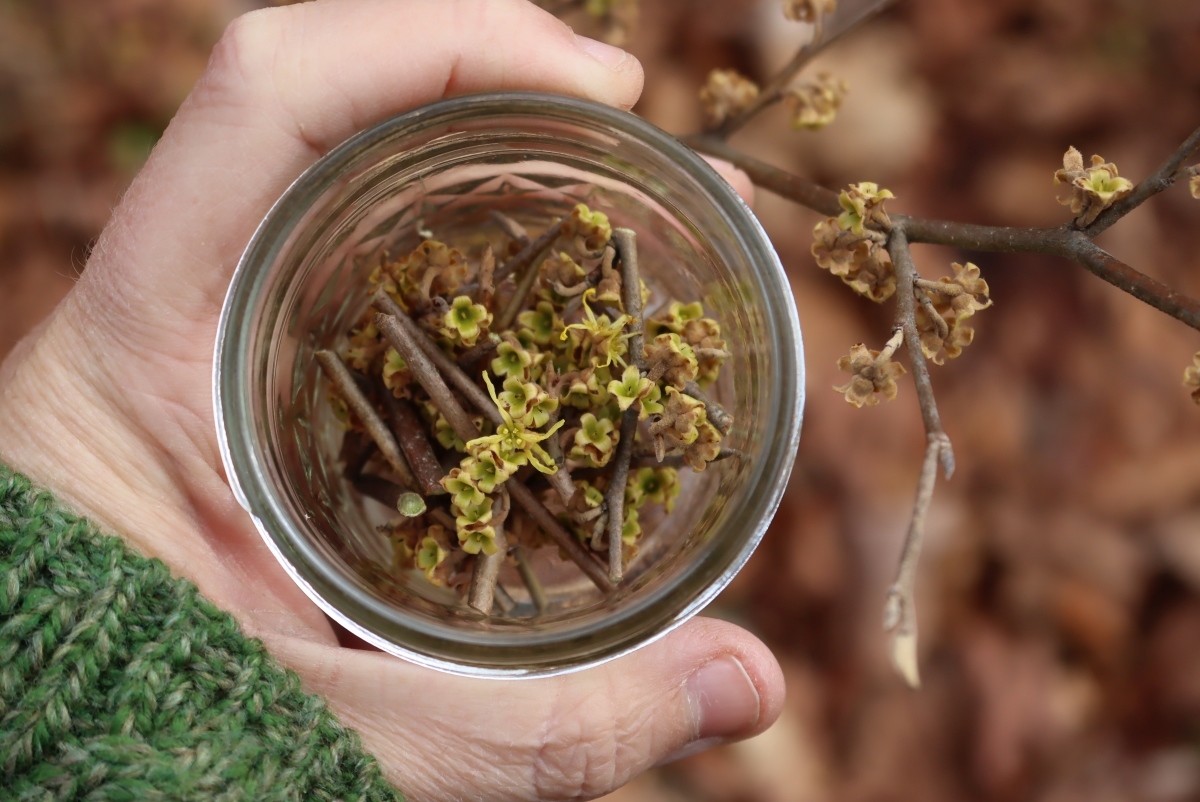
You can also just purchase dried witch hazel bark, which is easy enough to have on hand year-round. Starwest Botanicals sells dried witch hazel leaf, and other online sources sell dried witch hazel bark, so you can take your pick.
When using leaves, witch hazel extract is made as a gentle infusion (like making tea). For bark and twigs, they’re simmered for 20-30 minutes to make the extract.
Benefits of Witch Hazel Extract
These days, witch hazel extract is almost always used externally because what’s sold is a weak steam distillation of the twigs preserved with isopropyl alcohol. It’s not meant for consumption but for use as a topical disinfectant and anti-inflammatory.
Most often, you’ll see it recommended as an acne treatment, for cleaning wounds, or as a cooling anti-inflammatory pad for treating hemorrhoids.
Historically, a water extract of witch hazel was made fresh and used both internally and externally. According to the Chestnut School of Herbs,
“Native Americans have long used the twigs and bark of witch hazel as a medicinal herb, both internally and topically, for a wide variety of ailments. The tea is taken to remedy sore throats, diarrhea, intestinal bleeding, colds, coughs, bruising, and to prevent postpartum hemorrhaging.
The tannins in witch hazel help lessen the inflammation of mucous membranes in sinus congestion from allergies, sinus infections, and head colds. These same astringent tannins are also helpful for conditions related to the mouth: bleeding gums, gingivitis, and other infections.”
The Herbal Academy also has a list of benefits and uses of witch hazel, covering the various external uses of witch hazel extract for treating burns, dandruff, hemorrhoids, and many other things.
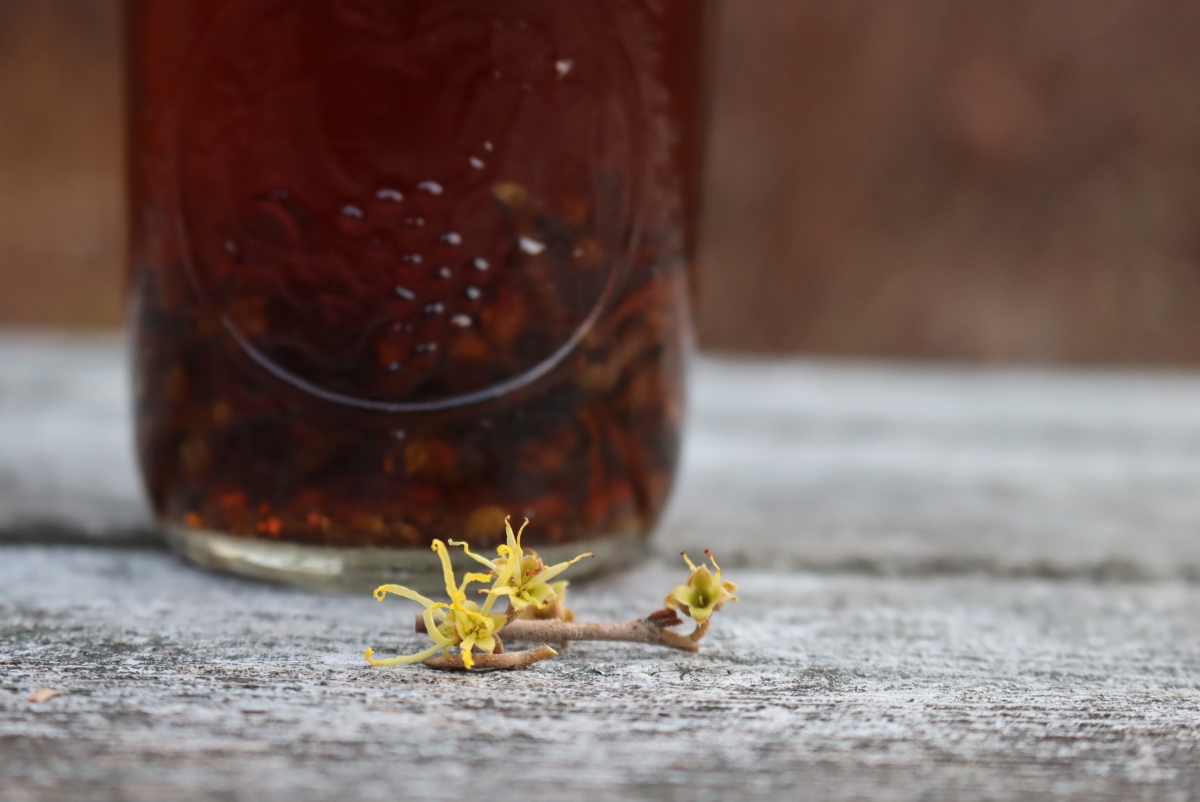
How to Make Witch Hazel Extract
Making witch hazel extract is pretty simple. Start with about a tablespoon of witch hazel bark in a cup of water.
Commercial witch hazel bark is finely chopped, so it’ll pack neatly into a tablespoon. I just have a rough 1/4 cup of twigs, which amounts to roughly the same amount.
Bring the water and bark to a simmer and gently cook for about 20-30 minutes. The volume will reduce by about half, and you’ll have roughly 1/2 cup of witch hazel extract after you filter the plant material.
While it’s simmering, your house will smell a bit like a hospital. The scent isn’t unpleasant, but it just smells strongly antiseptic, like an operating room after sterilization.
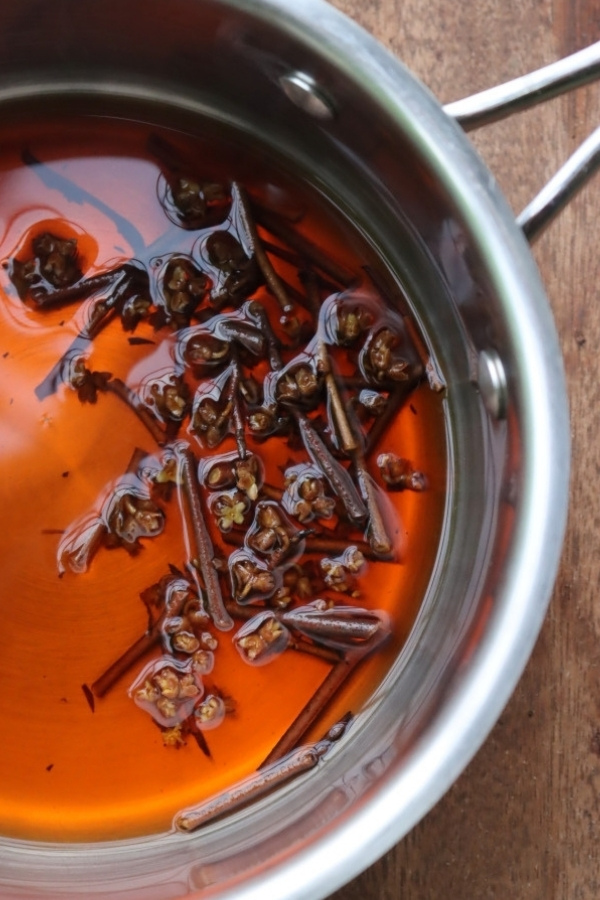
(If using leaves, use the same ratio, 1 tablespoon chopped leaves to a cup of water, but make an infusion by steeping the leaves for around 20 minutes.)
This fresh witch hazel extract is now ready for use. Since it’s not preserved with alcohol, it’ll spoil quickly. Removing as much plant material as possible will help it keep longer, but in the best of cases, it still should be kept in the refrigerator and used within a week.
Shelf Stable Witch Hazel Extract
If you’d like to make a shelf-stable witch hazel extract, you’ll need to add alcohol. A high-proof vodka, whisky, or rum works well. (Isopropyl alcohol will also work, but then it’s not for internal use.)
To be shelf-stable, the mixture will need at least 20% alcohol. Some sources suggest higher, around 30% alcohol. I’ve had homemade tinctures spoil at 20% alcohol, so now I opt for at least 25%.
The herbal academy suggests 25% for a 1-2 year shelf life and recommends higher alcohol concentrations for a longer shelf life.
If you’ve started with 1 cup of water and simmered it down to 1/2 cup extract, you’ll need to add 1/2 cup of 100 proof alcohol (50% ABV) to reach a final concentration of 25% alcohol.

I don’t happen to have any immediate use for witch hazel, so that’s what I did. I now have a half-pint mason jar with shelf-stable witch hazel extract ready to go if needed anytime within the next year.
Since witch hazel is sometimes made as a tincture instead of a water extract, I’m going to do a double extraction here. I’ve added the alcohol and I’ll leave the plant material in for a week or two before filtering. After that, I’ll top off the jar with a bit more 100-proof alcohol just to be sure it stays above 25% ABV.
This isn’t the “traditional” method, and usually, the plant material would be filtered before alcohol is added to stabilize the witch hazel extract.
(If you’re looking for another great way to preserve witch hazel, you can use it to make this Yarrow and Witch Hazel Soap. The infusion goes directly into the soap, and the soapmaking process makes the finished soap shelf stable. That way, you get the natural antibacterial properties of the witch hazel in a soap instead of a topical extract.)
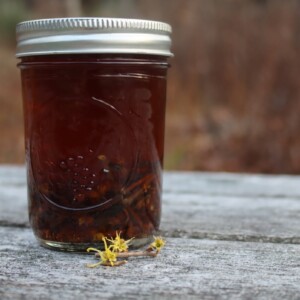
Witch Hazel Extract
Ingredients
- 1 Tbsp witch hazel bark or 1 tablespoon dried leaves for a gentler infusion
- 1 cup water
- 1/2 cup 100-proof alcohol optional, for shelf-stable extract
Instructions
- If using witch hazel bark, measure out 1 tablespoon of finely chopped bark. For leaves, you can use the same measurement but will need to make an infusion instead of a decoction.
- In a small pot, add the witch hazel bark and 1 cup of water. Bring it to a simmer, and cook for 20-30 minutes, stirring occasionally. The water should reduce by about half, leaving you with roughly 1/2 cup of witch hazel extract.
- Once the extract has simmered and reduced, strain out the bark (or leaves) using a fine mesh strainer or cheesecloth. Let the liquid cool to room temperature.
- If you want a shelf-stable extract, add 1/2 cup of 100-proof alcohol (vodka, rum, or whisky works well) to the cooled extract. This will bring the alcohol content to about 25%, which is ideal for preserving the extract for up to a year. Stir to combine.
- Transfer your witch hazel extract to a glass jar or bottle. If not adding alcohol, store the extract in the refrigerator and use within a week. If adding alcohol, it can be stored in a cool, dark place for up to a year.
Notes
Homemade Herbal Remedies
Looking for more Homemade herbal remedies?
- How to Make a Herbal Salve
- 20+ Immune Boosting Herbs and Mushrooms
- Yarrow Salve
- Comfrey Salve
- Echinacea Tincture
- Elderberry Syrup
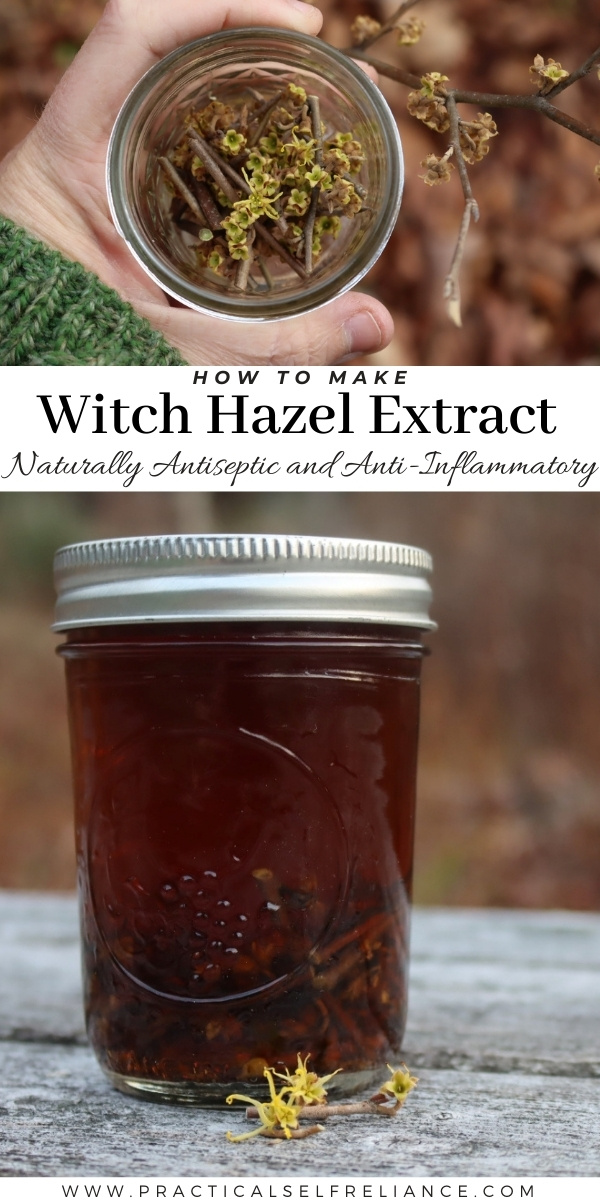


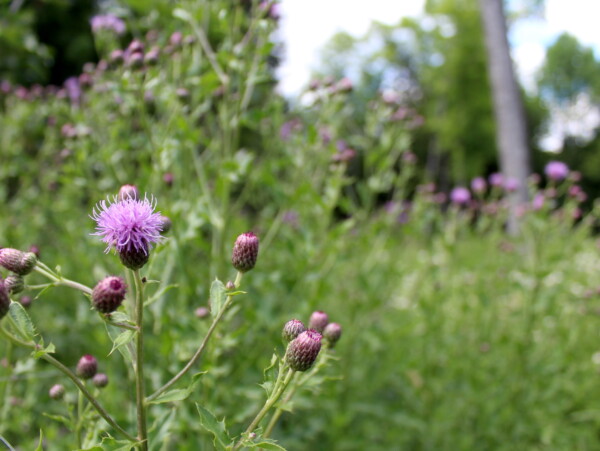
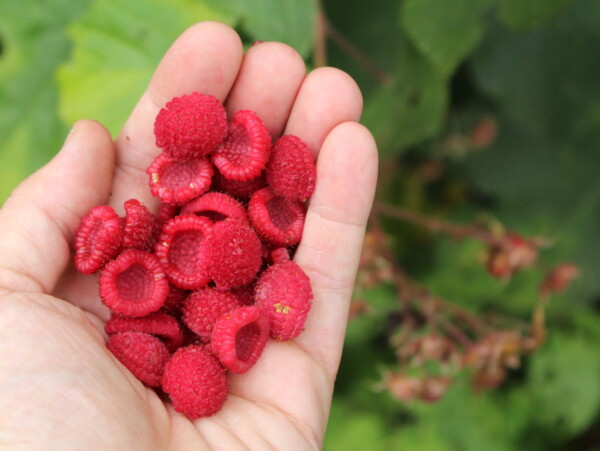










Nice and potent, and you have the bonus of knowing exactly what’s going into your medicine cabinet (with no unexpected additives).
Can this be made in larger quantities?
Yes, you can scale up the recipe as much as you need.
Very good information. Thank you.
I’m 63 years old. Up until now. I didn’t realize that I had a lot of this growing on my property. I will definitely try your recommendations. No more buying from the store
You’re very welcome. We can’t wait to find out how it works for you.
Thank you! I’d like to make some as only a toner for external use, do you think I could just make it an extract (bark and alcohol) instead of boiling it in water first? Or should I still boil it first, then add everything to a container with the alcohol like other tinctures?
If you just make the extract with alcohol then the alcohol content will most likely be way too high for you to want to use it on your skin directly. You also want to consider that different properties are extracted from water than alcohol. The best use for skin would be the water extract made in small batches and kept in the refrigerator or even frozen. If you want it to be shelf stable then I would do the water extract and add in the alcohol as described in the post.
Thank you for the help! I’ll do it as described then (:
You’re very welcome.
Thank you😊
You’re very welcome.
Hi all,
I was looking for a way to make homemade witch hazel and found your website.
Everything clear, except for the part when the author says she had spoilage with a 20% alcohol: how can this be, since at 20% ethanol it could be not ideal as sanitizer but should be enough alcohol to inhibit bacterial growth indefinitely?
Like fortified wines at 20% don’t spoil.
Maybe she intended spoilage as change in smell, but not related to bacteria?
Asking because would be concerned about the safety of the tincture.
Thanks
The Herbal Academy recommends a higher alcohol percentage for a longer shelf life. The percentage of alcohol will vary based on the length of time that you wish to store it.
Which Isopropyl alcohol do you recommend using 71% or 91%? How much of each would I use?
You can use any kind of alcohol that you want. Just remember if you are using isopropyl alcohol that it can’t be used internally. You can use any percentage that you want, you will just need to adjust your ratios to get the proper percentage of alcohol if you want it to be shelf stable.
Thank you for this enrich informations. Please I want to know how can I make liqurice extract to use It for whitening?
That’s not something that I personally have experience with so you will just have to do some research on it. Let us know if you decide to give it a try.
Very useful infomation on how to produce witch hazel extract. Thank you very much. My question is how can I get the clear colour like the commercial ones bought in stores? I noticed that the colour advertized on your site looks brown.
A proper alcohol extract will naturally have a darker color. Sometimes they are a green color or sometimes they are more brown depending on the plant material that is used. The witch hazel that is commonly found in stores doesn’t have much plant matter in it and is mainly alcohol which is why it has a clear color. Is there a particular reason why you want it to be clear?
Actually the reason its clear is that it has been distilled. You can Google ways to distill herbal hydrosols at home with basic kitchen equipment. Or look up how to distill rose water on YouTube you’ll get lots of videos that will show you the process. Just use the same process but with witch hazel twigs and you’ll have a nice clear extract. Then add alcohol to preserve it if you aren’t using it within a few days.
Thanks for all the great info! Does the final product need to be diluted at all? Or can it be used as it is? X
It can be used as is.
Are the blooms used as well?
Yes, you can use all aerial parts.
Great article, but where can I get a witch hazel plant?
I don’t have a good source for plants but I’m sure a quick internet search should help.
You can purchase with hazel bark or powder at http://www.pennherb.com.
What, please is ABV? acronyms should have a”key” so they are understandable to everyone
So sorry about that. ABV means alcohol by volume. It will always be shown on the label.
Hi! I tend to have to stay away from grain alcohol, even for external uses. Would an 80-proof potato/grape vodka (like Chopin or Lukusowa) work in terms of preservation, or does it have to be a grain-based 100 proof? Wondering if that 20 percent really does make a difference. Thanks!
You could definitely use an 80 proof alcohol. The most important factor in preservation is not necessarily the type of alcohol but the percentage. You want your final alcohol percentage to be 20 to 30% and 25% is suggested for 1 to 2 year shelf-life. If it’s 80 proof, you could simply add a little more alcohol to increase the percentage or just know that it will have a little shorter shelf life.
I used bark that I shaved off a couple of smaller limbs. The simmered down witch hazel looks correct but how do I know if i have a “good” batch of extract?
If you followed the directions in the post then you should have a good batch.
Do I add the 1/2 cup of alcohol during cooking or after?
Thanks
After cooking so that the alcohol doesn’t cook off. It should be cool when you add the alcohol.
Any chance you have a pick of the whole plant for reference or a link to a site that shows it?
Lots of good pictures here, including multiple different regional witch hazel species: https://en.wikipedia.org/wiki/Witch-hazel